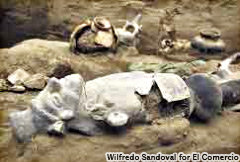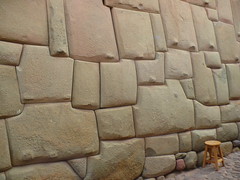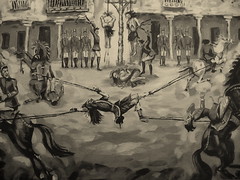Petroglyphs of Pusharo
Peru is covered with ancient rock-art sites, most are able to be connected with a culture and some meaning derived from them. The same is not true of those at Pusharo in Madre de Dios, on the edge of the Andes in the dense high-altitude rainforest.
It is thought the first non-native to see the Petroglyphs was a rubber-tapper in 1909. In 1921 a missionary examined and copied them declaring them to be scenes from the bible. In the 1960s explorer Carlos Neuenschwander arrived in the area by helicopter to see and examine the petroglyphs.
Gregory Deyermenjian, an explorer from New England, has gained relative fame for organising expeditions in the Cusco-Madre de Dios border area for years. His success in finding Inca ruins on the edge of the Amazon has encouraged others to continue the quest for the lost city of Paititi.
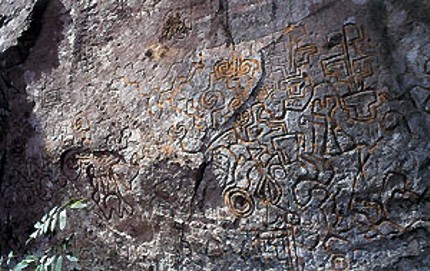
In his article for the Athena Review, Deyermenjian tells us, “I first encountered petroglyphs in 1984 while my party of highland campesinos and Peruvian adventurers was traversing the Cordillera de Paucartambo, the easternmost range of the high Andes to the northeast of Cusco. We were at an altitude of 13,500 feet when we found ourselves astride a rockhang covered with bas- relief images of llamas and walking humans. All the human figures on the rock were heading in one direction, northeast, toward the tropical forests This site is named Demarcación, whose meaning would doubtless have been understood by Incan peoples of old passing this way”.
In 1991 he was ready to head into the Pantiacolla region, in the hopes for finding the mythical lost city of Paititi. In the Amazon he would investigate Pusharo and its petroglyphs. He continues, “In the jungle, all words become softened. Pusharo would be the lowlander’s parlance for Pucharo, which some claimed was a corruption of the Quechua Pukara, meaning fortress, or of Puchu Karu, meaning far away remains“.
On arriving in the area he hiring locals of the Machiguenga tribe as guides. Deyermenjian and his party began their journey through the forest.
“After having trudged upriver to 2,600 feet, we heard a dog wildly barking, and then approached a small band 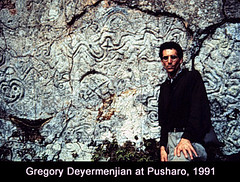 of Machiguenga, living by the river in what looked like a hastily constructed lodge of bent sticks covered with leaves .Soon the valley widened. This was it. As we moved from left to right along the length of the Pusharo monolith, the figures seemed to increase in baroque complexity. They covered the rock for three quarters of its length, and reached up to eight feet. “A picture’s worth a thousand words” was never more true. Having filmed and photographed all that I could of Pusharo, it was time to head back“.
of Machiguenga, living by the river in what looked like a hastily constructed lodge of bent sticks covered with leaves .Soon the valley widened. This was it. As we moved from left to right along the length of the Pusharo monolith, the figures seemed to increase in baroque complexity. They covered the rock for three quarters of its length, and reached up to eight feet. “A picture’s worth a thousand words” was never more true. Having filmed and photographed all that I could of Pusharo, it was time to head back“.
The mysterious petroglyphs seem to be related to many other petroglyphs found throughout Brasil and other Amazon regions. The feature geometric and abstract patterns for the most part. But what can they mean?
“Those who have commented upon Pusharo usually suggest any one of four possible interpretations. Some see it as a terrestrial map, with its various serpentine lines indicating rivers, mountains, and various other natural features. They see significance in the fact that it lies in a transitional zone between the lower selva and the highlands, thus being a crossroads for migrating populations that may have sculpted a map in the rock to record their wanderings, or the area from whence they came. Some see it as a gigantic map of the heavens. Some see in these Petroglyphs evidence of pre-Columbian trans-Atlantic contact”, states Deyermenjian.
He continues, “The Petroglyphs of Pusharo strike most viewers as weird, confusing, and fascinating. We may never know what these glyphs mean. We may, however, be able to understand something of the psychological and cultural motivations behind their creation. Whenever it was that these petroglyphs were carved, the northwest Amazon would have been home to countless hundreds of Amerindian tribal groups. Although most of these groups lived far away from each other, they must have nonetheless shared many life experiences in their relatively similar physical environment. They also undoubtedly partook of the same hallucinogenic plants, especially Ayahuasca, but also Brugmansia. They must have seen similar visions, and expressed them graphically on their houses, on rocks by rivers, with an especially lush flowering of expression emerging at Pusharo“.
Perhaps with more investigation we can decipher what these images represent and who left them. The difficulty is there are so many ancient ruins and associated mysteries, it will be a long while before we solve them all.
Tags: cusco, deyermenjian, madre de dios, paititi, petroglyph, pusharo, rainforest, rock art







